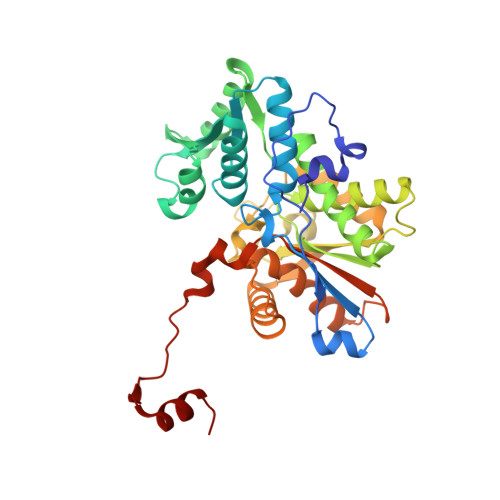Product-assisted catalysis as the basis of the reaction specificity of threonine synthase.
Murakawa, T., Machida, Y., Hayashi, H.(2011) J Biol Chem 286: 2774-2784
- PubMed: 21084312
- DOI: https://doi.org/10.1074/jbc.M110.186205
- Primary Citation of Related Structures:
3AEX, 3AEY - PubMed Abstract:
Threonine synthase (TS), which is a pyridoxal 5'-phosphate (PLP)-dependent enzyme, catalyzes the elimination of the γ-phosphate group from O-phospho-L-homoserine (OPHS) and the subsequent addition of water at Cβ to form L-threonine. The catalytic course of TS is the most complex among the PLP enzymes, and it is an intriguing problem how the elementary steps are controlled in TS to carry out selective reactions. When L-vinylglycine was added to Thermus thermophilus HB8 TS in the presence of phosphate, L-threonine was formed with k(cat) and reaction specificity comparable with those when OPHS was used as the substrate. However, in the absence of phosphate or when sulfate was used in place of phosphate, only the side reaction product, α-ketobutyrate, was formed. Global analysis of the spectral changes in the reaction of TS with L-threonine showed that compared with the more acidic sulfate ion, the phosphate ion decreased the energy levels of the transition states of the addition of water at the Cβ of the PLP-α-aminocrotonate aldimine (AC) and the transaldimination to form L-threonine. The x-ray crystallographic analysis of TS complexed with an analog for AC gave a distinct electron density assigned to the phosphate ion derived from the solvent near the Cβ of the analog. These results indicated that the phosphate ion released from OPHS by γ-elimination acts as the base catalyst for the addition of water at Cβ of AC, thereby providing the basis of the reaction specificity. The phosphate ion is also considered to accelerate the protonation/deprotonation at Cγ.
Organizational Affiliation:
Department of Biochemistry, Faculty of Medicine, Osaka Medical College, Takatsuki 569-8686, Japan.















